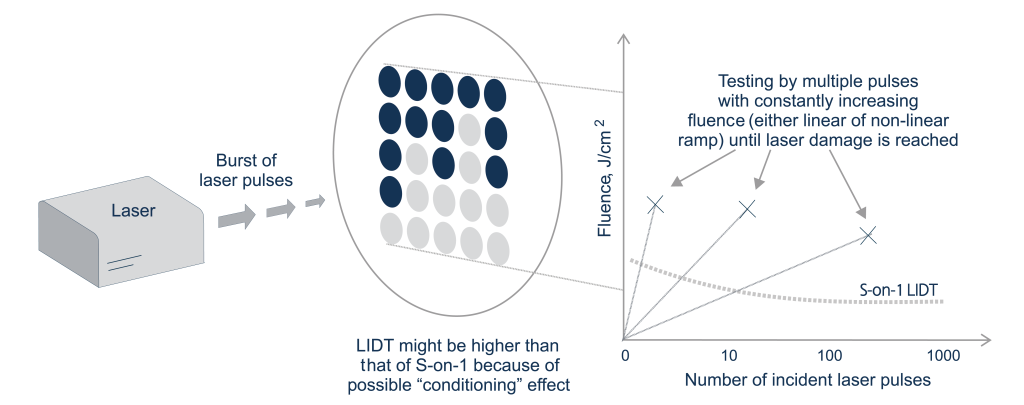
R-on-1 LIDT test
R(amp)-on -1 testing protocol provides preliminary information about the LIDT of the surface-limited samples (e.g. fibers, small crystals). It is also used to investigate the conditioning effect.
R-on-1 test explained:
Use this test for:
- Testing of preliminary LIDT of surface limited samples (such as fibers or samples with small aperture: when S-on-1 is unavailable);
- Investigation of conditioning/annealing effect (in combination with 1-on-1);
- Only relatively compare production processes or vendors;
Test description
To perform an R-on-1 test procedure several test sites (minimum – 1, typically – 10, best – as as many as possible) are selected on the test area. Each of those sites is interrogated with a laser irradiation level (for instance, fluence) that increases step wise. Starting from very low irradiation values, it is linearly or non-linearly increased until a damage event is detected or the maximum irradiation level of the system is reached. Based on the application each test site can be exposed to single or multiple laser pulses (S) at each irradiation level.
Known limitations and risks:
- Not suited for characterization of samples with low defect density;
- Not suited for large optics characterization;
- Provides only a rough (not accurate) estimate of LIDT value (order of magnitude);
- Continuous laser interaction with the material might also cause conditioning (annealing) or fatigue (accumulation or incubation) effects, which compromises LIDT accuracy;
- Might be time consuming if incremental fluence is too small;

Most popular test parameters for this test
| Wavelength | Pulse duration(1) | Repetition rate | Pulses per irradiation level | Interested? |
| 1064 nm | 10 ns | 100 Hz | 1000 | ORDER |
| 532 nm | 5 ns | 100 Hz | 1000 | ORDER |
| 355 nm | 5 ns | 100 Hz | 1000 | ORDER |
| Custom | Check all availability or configure your own at my.lidaris.com | |||
(1) effective pulse duration measured at Full Width Half Maximum
Testing
conditions
Check out all available testing capabilities. Identify your system in our “Available testing conditions” table.
Related tests
Show all-
ISO 1-on-1
LIDT test (21254-1,2)Single-shot technique for determination of “intrinsic” laser-induced damage threshold of coatings.read more -
R-on-1
LIDT testTesting protocol, which provides preliminary information about the LIDT of the surface-limited samplesread more -
 ISO LIDT Certification Test (21254-1,3)This technique is designed to separate good and bad optics when end-use irradiation conditions are knownread more
ISO LIDT Certification Test (21254-1,3)This technique is designed to separate good and bad optics when end-use irradiation conditions are knownread more -
ISO S-on-1
LIDT test (21254-1,2)The most popular technique used for laser-induced damage threshold (LIDT) characterization of laser optics.read more

Test bundles and packages
-
Find out more ›
Optics Characterization Bundle for CW regime at 1070 nm
The testing package consists of multiple tests, which are carefully selected to address optics characterization issues at the CW regime. -
Find out more ›
Lifetime + Certification Bundle for Industrial Grade fs-ps Laser Optics
The package consists of several tests carefully selected to address optics certification for critical applications.
more tools
and useful information
-
Find out more ›
Testing conditions
Check out all available laser damage testing conditions (wavelengths, pulse regimes, environments, and more). -
Find out more ›
Laser Damage infobase
Check out a useful glossary of terms and simple explanations related to the main topics of laser damage terminology. -
Find out more ›
Online Fluence calculator
Check out a calculator equipped with laser-related calculus that is frequently required in practice: such as laser fluence. -
Find out more ›
Downloads and docs
Here you can download all information about laser damage testing available at Lidaris. -
Find out more ›
New client guide
Here you will find usefull guidlines and suggestions for everyone, who is new the laser damage field. -
Find out more ›
Orders FAQ
Fast way to find out about test samples prepration, handling, and shipping.
Have
Questions?
Feel free to let us know if you have any concerns. We can always help you with choosing the right solution for your specific needs.
